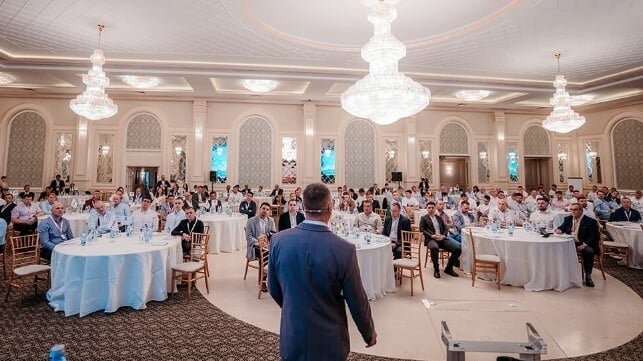Seaspan Conference Brings Message of Hope for Ukrainian Seafarers

Container shipping fleet management company Seaspan Corporation held its European seafarer’s conference on the 2nd and 3rd of October at the Hotel Del Mar in Mamaia, bringing together maritime industry professionals from three continents for the first time in Constanta.
The event was organized by Seaspan’s regional manning office in Odesa, Ukraine, in cooperation with Stargate Crewing, one of Seaspan’s crew providers in Romania. Other conference participants were UNIVIS and Alfa Navigation, Seaspan’s crewing agencies in Ukraine, Harren & Partner from Turkey, Navmar Shipping from Romania, Hanseatic Marine Services from Hamburg, and DNV and Gard from Norway
War in Ukraine has thrown global seafarer sourcing in disarray. Thousands of Ukrainian seafarers have relocated to Romania and other EU countries to keep sailing on international waters. According to local ITF estimates, between 8,000 and 10,000 Ukrainian seafarers currently spend their home leave in Romania.
Seaspan has seen phenomenal growth in the last couple of years, undertaking a massive newbuilding program that is arguably one of the biggest in recent memory. “The fully delivered fleet, at the end of next year, will put us at a level of being among the biggest containership owners in the world,” said Seaspan Chief Operating Officer Torsten Pedersen. “For people here, it means more career prospects and better opportunities.”
With growth comes the challenges that any fast-growing organization must deal with. “The focus going forward is ensuring that we are not becoming too complex as an organization as we grow… and simplify things. We are a big company but act internally like a small company.” Mr. Pedersen said.
For Seaspan, digitization and decarbonization are two critical policy objectives in the coming years, and Mr. Pedersen was careful at pointing out that neither would affect the company’s manning policy. “Seaspan recruitment policy will not change. When people join Seaspan, we have tough intake requirements. But once you are through the eye of the needle, we take care of you.”
“We have a strong culture onboard our ships, and with the intake of 2000 new seafarers over the (coming) years, we will maintain the culture. Experienced people will help get the new people embedded into our culture,” he added.
Captain Manoj Gandhi, Director of Fleet Personnel, Seaspan Crew Management, gave insight into the company’s accelerated growth strategy for its seafaring personnel. In his address, he spoke of Inclusive Growth.
“Inclusive growth means it is beneficial for all.” Captain Gandhi explains that the company’s growth was now making it possible to give its seafarers more money and a better life for their families.
Seaspan continuously identified prospects from among those serving on board and put them on the fast track for promotion. Of course, quality had to be maintained while considering advancements, and the approval process remains among the most stringent in the industry.
As the Seaspan fleet expands from 1.2 million TEUs in March 2023 to a projected nearly 2 million TEUs by the end of 2024, the company has planned for the additional staffing well in advance.
“We have our own cadetship programs and increase the intake of cadets as new ships come in. We also looked at people who could be promoted and gave them promotions. That took care of 50% of our additional requirements, and the remaining we recruit from the market.” Captain Gandhi elaborates, adding that Seaspan had built up a surplus of reserves over a long period to deal with staffing requirements.
At the same time, the company is tailoring accommodation and housekeeping facilities on many of its new vessels to suit women seafarers. Captain Gandhi and Seaspan’s new building experts compiled a list of shipboard modifications necessary to attract more women seafarers to join the team. The feedback for this list came directly from the company’s existing corps of women seafarers.
Saugata Bagchi is a business writer based in Constanta, Romania.
The opinions expressed herein are the author's and not necessarily those of The Maritime Executive.
